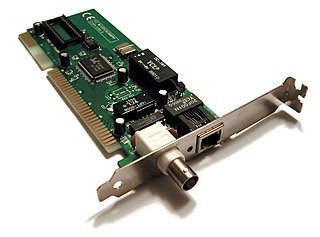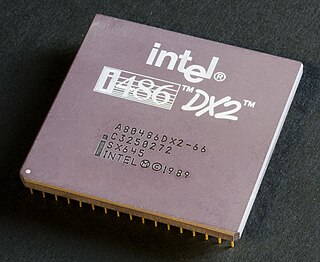
Wake-on-LAN (WoL) is an Ethernet or token ring computer networking standard that allows a computer to be turned on or awakened by a network message.
Wintel is a portmanteau of Microsoft Windows and Intel, referring to personal computers using Intel x86-compatible processors running Microsoft Windows.

A network interface controller is a computer hardware component that connects a computer to a computer network.
The Network Computer was a diskless desktop computer device made by Oracle Corporation from about 1996 to 2000. The devices were designed and manufactured by an alliance, which included Sun Microsystems, IBM, and others. The devices were designed with minimum specifications, based on the Network Computer Reference Profile. The brand was also employed as a marketing term to try to popularize this design of computer within enterprise and among consumers.

In computing, the Preboot eXecution Environment specification describes a standardized client-server environment that boots a software assembly, retrieved from a network, on PXE-enabled clients. On the client side it requires only a PXE-capable network interface controller (NIC), and uses a small set of industry-standard network protocols such as DHCP and TFTP.

Netbook is a generic name given to a category of small, lightweight, legacy-free, and inexpensive laptop computers that were introduced in 2007. Netbooks compete in the same market segment as mobiles and Chromebooks.
The Apple–Intel architecture, or Mactel, is an unofficial name used for Apple Macintosh personal computers developed and manufactured by Apple Inc. that use Intel x86 processors, rather than the PowerPC and Motorola 68000 ("68k") series processors used in their predecessors. With the change in architecture, a change in firmware became necessary; Apple selected the Intel-designed Extensible Firmware Interface (EFI) as its comparable component to the Open Firmware used on its PowerPC architectures, and as the firmware-based replacement for the PC BIOS from Intel. With the change in processor architecture to x86, Macs gained the ability to boot into x86-native operating systems, while Intel VT-x brought near-native virtualization with Mac OS X as the host OS.
Steven McGeady is a former Intel executive best known as a witness in the Microsoft antitrust trial. His notes and testimony contained colorful quotes by Microsoft executives threatening to "cut off Netscape's air supply" and Bill Gates' guess that "this anti-trust thing will blow over". Attorney David Boies said that McGeady's testimony showed him to be "an extremely conscientious, capable and honest witness," while Microsoft portrayed him as someone with an "axe to grind." McGeady left Intel in 2000, but later again gained notoriety for defending his former employee Mike Hawash after his arrest on federal terrorism charges. From its founding in 2002 until its sale in November 2013, he was Chairman of Portland-based healthcare technology firm ShiftWise. He is a member of the Reed College Board of Trustees, the Portland Art Museum Board of Trustees, and the PNCA Board of Governors, and lives in Portland, Oregon.
Intel vPro technology is an umbrella marketing term used by Intel for a large collection of computer hardware technologies, including Hyperthreading, Turbo Boost 3.0, VT-x, VT-d, Trusted Execution Technology (TXT), and Intel Active Management Technology (AMT). When the vPro brand was launched, it was identified primarily with AMT, thus some journalists still consider AMT to be the essence of vPro.
In computer science and computer programming, system time represents a computer system's notion of the passage of time. In this sense, time also includes the passing of days on the calendar.

Windows IoT, formerly Windows Embedded, is a family of operating systems from Microsoft designed for use in embedded systems. Microsoft currently has three different subfamilies of operating systems for embedded devices targeting a wide market, ranging from small-footprint, real-time devices to point of sale (POS) devices like kiosks. Windows Embedded operating systems are available to original equipment manufacturers (OEMs), who make it available to end users preloaded with their hardware, in addition to volume license customers in some cases.
Microsoft Hyper-V, codenamed Viridian and formerly known as Windows Server Virtualization, is a native hypervisor; it can create virtual machines on x86-64 systems running Windows. Starting with Windows 8, Hyper-V superseded Windows Virtual PC as the hardware virtualization component of the client editions of Windows NT. A server computer running Hyper-V can be configured to expose individual virtual machines to one or more networks.
Windows XP has been released in several editions since its original release in 2001.
In computing, virtualization refers to the act of creating a virtual version of something, including virtual computer hardware platforms, storage devices, and computer network resources.

The Mini DisplayPort is a miniaturized version of the DisplayPort audio-visual digital interface.
This article presents a timeline of events in the history of x86 DOS disk operating systems from 1973 to 2016. Other operating systems named "DOS" are generally not part of the scope of this timeline.

Windows 3.0, a graphical environment, is the third major release of Microsoft Windows, and was released on May 22, 1990. It became the first widely successful version of Windows and a rival to Apple Macintosh and the Commodore Amiga on the graphical user interface (GUI) front. It was followed by Windows 3.1.

Wireless Display (WiDi) was technology developed by Intel that enabled users to stream music, movies, photos, videos and apps without wires from a compatible computer to a compatible HDTV or through the use of an adapter with other HDTVs or monitors. Intel WiDi supported HD 1080p video quality, 5.1 surround sound, and low latency for interacting with applications sent to the TV from a PC.
PLATINUM is the name given by Microsoft to a cybercrime collective active against governments and related organizations in South and Southeast Asia. They are secretive and not much is known about the members of the group. The group's skill means that its attacks sometimes go without detection for many years.









